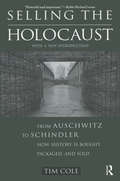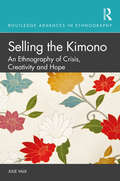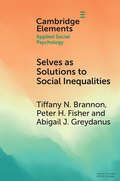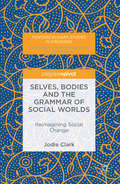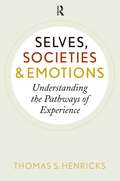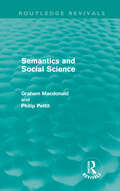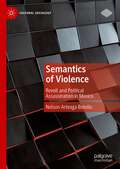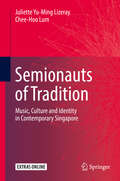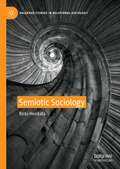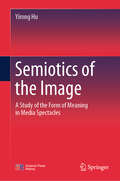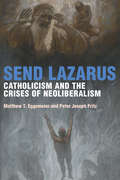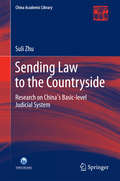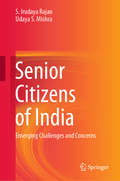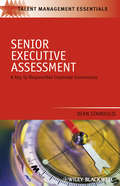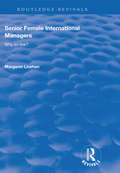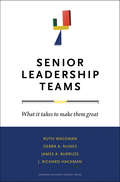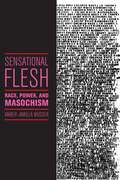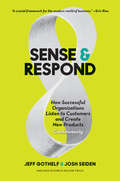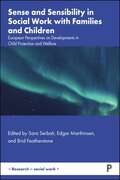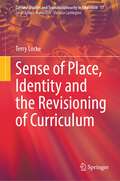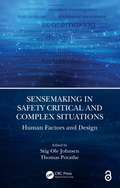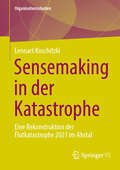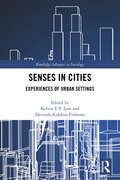- Table View
- List View
Selling the Holocaust: From Auschwitz to Schindler; How History is Bought, Packaged and Sold
by Tim ColeCole shows us an "Auschwitz-land" where tourists have become the "ultimate ruberneckers" passing by and gazing at someone else's tragedy. He shows us a US Holocaust Museum that provides visitors with a "virtual Holocaust" experience.
Selling the Kimono: An Ethnography of Crisis, Creativity and Hope (Routledge Advances in Ethnography)
by Julie ValkBased on twelve months of in-depth ethnographic research in Japan with retailers, customers, wholesalers, writers and craftspeople, Selling the Kimono is a journey behind the scenes of a struggle to adapt to difficult economic conditions and declining demand for the kimono. The kimono is an iconic piece of clothing, instantly recognised as a symbol of traditional Japanese culture. Yet, little is known about the industry that makes and sells the kimono, in particular the crisis this industry is currently facing. Since the 1970s, kimono sales have dropped dramatically, craftspeople are struggling to find apprentices, and retailers have closed up shop. Illuminating recent academic investigations into the lived experience of economic crisis, this volume presents a story of an industry in crisis, and the narratives of hope, creativity and resilience that have emerged in response. The ethnographic depth and theoretical contribution to understanding the effects of economic crisis and the transformation of traditional culture will be of broad interest to students, academics and the general public.
Selling to the New Elite: Discover the Secret to Winning Over Your Wealthiest Prospects
by Jim Taylor Stephen Kraus Doug HarrisonBased on unprecedented research, The New Elitetook a behind-the-scenes look at America's most powerful and influential class - what motivates them, how they think, where they shop, and how they really spend their money. In this practical and fascinating follow-up, the authors reveal how salespeople and marketers can hone in on this wealthy class, pique their interest, and convert them into loyal customers. Presenting the best practices behind hundreds of mutually satisfying interactions between salespeople and buyers - based on studies of elite companies such as Lexus, Chanel, Neiman Marcus, Four Seasons, Cartier, and Louis Vuitton - Selling to the New Elitereveals what the truly rich want from brands, what they expect from the marketplace, and how the Great Recession has reshaped their purchasing patterns. Loaded with insight and indispensable techniques, this one-of-a-kind guide shows readers everywhere how they can win over the wealthiest customers. . . and become rich themselves.
Selves as Solutions to Social Inequalities: Why Engaging the Full Complexity of Social Identities is Critical to Addressing Disparities (Elements in Applied Social Psychology)
by Tiffany N. Brannon Peter H. Fisher Abigail J. GreydanusSocial disparities tied to social group membership(s) are prevalent and persistent within mainstream institutions (e.g., schools/workplaces). Accordingly, psychological science has harnessed selves - which are malleable and meaningfully shaped by social group membership(s) - as solutions to inequality. We propose and review evidence that theoretical and applied impacts of leveraging 'selves as solutions' can be furthered through the use of a stigma and strengths framework. Specifically, this framework conceptualizes selves in their fuller complexity, allowing the same social group membership to be associated with stigma, risk, and devaluation as well as strengths, resilience, and pride. We provide evidence that by enacting policies and practices that (a) reduce/minimize stigma and (b) recognize/include strengths, mainstream institutions can more fully mitigate social disparities tied to inclusion, achievement and well-being. Using social groups that vary in status/power we examine implications of this framework including the potential to foster positive, recursive, and intergroup impacts on social inequalities.
Selves, Bodies and the Grammar of Social Worlds
by Jodie ClarkThis book is an invitation to researchers who are committed to social change to look for ideas about transformation in an unexpected place - that is, in the data generated from empirical research. Informed by Critical Discourse Analysis and postmodern theory, it proposes a method of locating, through close grammatical analysis of everyday descriptions of the social world, the desire for alternative transformative structures. Drawing upon insightful analysis of conversational data collected over a period of 12 years from both 'marginalised' and 'mainstream' participants, it reveals innovative ways of imagining social structure. Clark proposes a view of the social world as in an embodied relationship with embodied selves.
Selves, Societies, and Emotions: Understanding the Pathways of Experience
by Thomas S. HenricksBuilding on contributions from sociology, psychology, anthropology, philosophy, literature, and neuroscience, Henricks develops a more general account of how people discover and reproduce the "meanings" of their involvements with others. Among its many themes are treatments of selves as "projections of personhood," of the ways in which self-expression has changed historically and is now experienced in our electronically mediated era, of emotions as "framing judgments," and of ritual, play, communitas, and work as four distinctive "pathways of experience."
Semantics and Social Science (Routledge Revivals)
by Philip Pettit Graham MacDonaldOriginally published in 1980, this book examines the major issues in the philosophy of social science, paying specific attention to cross-cultural understanding, humanism versus scientism, individualism versus collectivism, and the shaping of theory by evaluative commitment. Arguing for a cross-cultural conception of human beings, the authors defend humanism and individualism, and reject the notion that social inquiry is necessarily vitiated by an adherence to values.
Semantics of Violence: Revolt and Political Assassination in Mexico (Cultural Sociology)
by Nelson Arteaga BotelloThis book describes three impactful cases of political violence that broke out in Mexico in 1994, pointing to an important juncture in Mexican political development. At that point, the patrimonial order centered on the PRI and the Mexican presidency entered a momentous crisis that is still ongoing after a quarter of a century and caused the patrimonial order and the civil order to compete over Mexican public life. Such competition, in turn, unfolds at the cultural level on the terrain of three semantics of political violence that shape public debates over violence in Mexico. Ultimately, this book sheds light over the refraction of patrimonial and civil attributions across such cultural terrains.
Semionauts of Tradition: Music, Culture and Identity in Contemporary Singapore
by Chee-Hoo Lum Juliette Yu-Ming LizerayThis book explores questions of identity, cultural change and creativity from the perspective of contemporary musicians currently engaged in redefining Asian musical traditions and notions of heritage in Singapore. Drawing on the fields of anthropology, cultural studies, and ethnomusicology, Semionauts of Tradition focuses on emerging millennial musicians and explores the complex and interwoven cultural, national, musical, and personal identifications in their discourse and music practice. It shows how they create fluid, hybrid and counter-hegemonic forms of expression, representation and identity through their navigation of diverse cultural worlds, their incorporation of a myriad of elements into their own identities and music, and their contestations of preconceived notions of difference and tradition. The book exposes paradoxes within current thinking about ‘multiracialism’, ‘racial harmony’, the ‘East/West divide’ and ‘tradition versus modernity,’ and proposes new ways of understanding identity, cultural change and creativity in a highly globalised, and diverse nation. This highly-original polyvocal account of a burgeoning music scene includes photos, musical scores and reaction pieces by musicians. It is a timely contribution to global discussions about ‘multiculturalism from below,’ as well as musical, cultural and national identities in a postcolonial Southeast Asian setting, from the viewpoint of artists engaged in creative meaning-making. "This captivating book explores - with tremendous intellectual vitality - the dialectic relationships between the cultural, ethnic and national identities of Singapore’s creative youth, and their creative practice. A compelling read!" Dr Liora Bresler, Professor, University of Illinois "A well-researched and thoughtfully well-written book about the diverse forms of music in Singapore and the musicians who created it." - Jeremy Monteiro, jazz pianist, singer, composer, and music educator "This wonderfully lucid and compelling book analyzes the musical and cultural creativity of young Singaporean musicians growing up in a multicultural and ethnically plural society, bringing Asian and Western musical cultures into creative dialogue." - Dr Deborah Pacini Hernandez, Professor Emeritus, Tufts University "A thought provoking dialogue on contemporary Singaporean music!" -Eric Watson, composer, conductor, music technologist and pedagogue
Semiotic Sociology (Palgrave Studies in Relational Sociology)
by Risto HeiskalaSemiotic Sociology provides solid ground for cultural analysis in the social sciences by building up a mediation between structuralist semiology (Saussure), pragmatist semiotics (Peirce), and phenomenological sociology (Schutz, Garfinkel, Berger and Luckmann). This is a deviation from the common view that these traditions are seen as mutually exclusive alternatives and thus competitors of each other. The net result of the synthesis is that a new social theory emerges wherein action theories (Weber and rational choice) are based on phenomenological sociology and phenomenological sociology is based on neostructuralist semiotics, which is a synthesis of the Saussurean and the Peircean traditions of understanding habits of interpretation and interaction. The core issues of social research are then addressed on these grounds. The topics covered include the economy/society relationship, power, gender, modernity, institutionalization, the canon of current social theory including micro/macro and agency/structure relations, and the grounds of social criticism.
Semiotics of the Image: A Study of the Form of Meaning in Media Spectacles
by Yirong HuThis book provides a groundbreaking exploration of image semiotics. Going far beyond traditional analyses of static visual texts, it includes dynamic imagery, literary iconography, and psychological images, offering a holistic view of how semiotics permeates various forms of media and cultural expression. The book integrates various case studies on Chinese culture, providing scholars outside China a unique lens through which to understand Chinese cultural thinking through semiotics. This approach not only enriches the academic discussion but also enhances cross-cultural understanding. In addition, the book collects and synthesizes significant achievements in semiotics, incorporating traditional visual theory research from the Panofsky and Warburg schools. This synthesis forms a comprehensive “semiotics of images,” providing an interdisciplinary analytical framework for contemporary “media spectacles.” The book employs multiple methodologies to dissect the visual image spectacles constructed by modern media signs, culminating in a macro-level understanding of cultural spectacles. Furthermore, it situates the comparison between Chinese and Western civilizations within a broad context of cultural philosophy and history, enriching the discourse on cultural differences and similarities.
Send Lazarus: Catholicism and the Crises of Neoliberalism (Catholic Practice in North America)
by Matthew T. Eggemeier Peter Joseph FritzToday’s regnant global economic and cultural system, neoliberal capitalism, demands that life be led as a series of sacrifices to the market. Send Lazarus’s theological critique wends its way through four neoliberal crises: environmental destruction, slum proliferation, mass incarceration, and mass deportation, all while plumbing the sacrificial and racist depths of neoliberalism.
Sending Law to the Countryside
by Suli ZhuBased on empirical investigation and an interdisciplinary approach, this book offers a crucial theoretical work on China's basic-level judicial system and a masterpiece by Professor Suli Zhu, a prominent jurist on modern China. Its primary goal is to identify issues - ones that can only be effectively sensed and raised by China's jurists because of their unique circumstances and cultural background - that are of practical significance in China's basic-level judicial system, and of theoretical significance to juristic systems in general. Divided into four parts, the book begins with a discussion of the systematic and theoretical problems in China's basic-level judicial system at the macro-, meso- and micro- scale. In the second part, it examines the technology and knowledge to be found in the basic-level judicial system, so as to make the traditionally "invisible" technology and knowledge of trial judges available for general theoretical analyses. The third part focuses on the judge and other legal personnel in the judicial system, while the last part discusses the value of legal sociology surveys as powerful resources. This book not only presents essential features of China's judicial system by precisely describing key issues in its basic-level judicial system, but also offers well-founded content that accentuates the significance of social management innovation.
Senior Citizens of India: Emerging Challenges and Concerns
by Udaya S. Mishra S. Irudaya RajanThis book provides an overview of multiple facets of ageing and its evolving dynamics in various Indian states. It elaborates on key dimensions like health, dependence and disability, as well as living arrangements for the elderly. Drawing on information from National Sample Surveys to offer readers a broader and richer understanding of the evolving demographic reality in India, the book addresses a range of detailed policies and programmes for the elderly in India. Given its scope, the book is essential reading for students and researchers in the fields of sociology, demography, economics and development studies. It also offers a valuable reference guide for anyone engaged in planning and policy formulation for social security, welfare of the aged or mainstreaming ageing concerns.
Senior Executive Assessment
by Dean StamoulisSenior Executive Assessment is a concise and practical guide that demystifies assessment that is conducted at the senior-executive level. Defines Senior Executive Assessment, describes its benefits, and explains how it differs from assessment at lower levels Discusses how significant shifts in markets and business models can require a change in the characteristics needed in senior executives Provides a practical model with suggestions for assessing senior executives Offers guidelines for determining what assessment methods to use in an organization Examines practical considerations in how to choose professionals to conduct senior executive assessment
Senior Female International Managers: Why So Few? (Routledge Revivals)
by Margaret LinehanThis title was first published in 2000: Linehan (management, Cork Institute of Technology) studies 50 European senior female managers in a variety of organizations who have made at least one career move across national borders. She compares the careers of these women with a number of theoretical explanations for the relative dearth of women in these positions. She finds that many of the problems facing domestic female managers also face international managers specifically, assumptions that management skills and organizational commitment are societally associated with masculinity.
Senior Leadership Teams and the Agile Organization (SIOP Organizational Frontiers Series)
by Richard J. Klimoski Stephen J. Zaccaro Nathan J. HillerSenior Leadership Teams and the Agile Organization builds on existing knowledge in the leadership, teams, and strategic management literatures to examine and explore how senior leadership teams drive the dynamic capabilities of organizations. Organizational agility is a key dimension of organizational performance. This volume focuses on senior leadership team processes and attributes that facilitate organizational agility and the organization’s capacity to perform and rapidly pivot in response to shifting strategic demands. Chapters summarize the current state of knowledge, examine past research and theory, define research and theoretical gaps, and consider how to address these gaps. In so doing, they offer an understanding of how senior leadership teams drive and enable organizational activity. The book is essential reading for researchers and professionals looking to understand the intersection of leadership, team dynamics, organizational psychology, organizational psychology, and strategic management, particularly in relation to organizational agility and the senior leadership team.
Senior Leadership Teams: What It Takes to Make Them Great
by J. Richard Hackman Ruth Wageman Debra A. Nunes James A. BurrussAn organisation's fate hinges on its CEO--right? Not according to the authors ofSenior Leadership Teams. They argue that in today's world of neck-snapping change, demands on leaders in top roles are rapidly outdistancing the capabilities of any one person - no matter how talented. Result? Chief executives are turning to their enterprise's senior leaders for help. Yet many CEOs stumble when creatinga leadership team. One major challenge is that senior executives often focus more on their individual roles than on the top team's shared work. Without the CEO's careful attention to setting the team up correctly, these high-powered managers often have difficulty pulling together to move their organisation forward. Sometimes they don't even agree about what constitutes the right path forward. The authors explain how to determine whether your organisation needs a senior leadership team. Then, drawing on their study of 100+ top teams from around the world, they explain how to create a clear and compelling purpose for your team, get the right people on it, provide structure and support, and sharpen team members' competencies - and your own. Timely and practical, this book enables you to create and sustain a leadership team whose members learn from one another while collaborating to pursue your company's objectives.
Sensational Flesh: Race, Power, and Masochism (Secular Studies #43)
by Amber Jamilla MusserThis &“lively and enlightening contribution to queer studies&” investigates power, race, and gender through the lens of masochism (Darieck Scott, author of Extravagant Abjection). In everyday language, masochism is usually understood as the desire to abdicate control in exchange for sensation—pleasure, pain, or a combination thereof. Yet at its core, masochism is a site where power, bodies, and society come together. Drawing on rich and varied sources—from nineteenth century sexology, psychoanalysis, and critical theory to literary texts and performance art—Amber Jamilla Musser employs masochism as a diagnostic tool for probing relationships between power and subjectivity. Engaging with a range of debates about lesbian S&M, racialization, femininity, and disability, as well as key texts such as Sacher-Masoch&’s Venus in Furs, Pauline Réage&’s The Story of O, and Michel Foucault's History of Sexuality, Musser renders legible the complex ways that masochism has been taken up by queer, feminist, and critical race theories. Furthering queer theory&’s investment in affect and materiality, she proposes &“sensation&” as an analytical tool for illustrating what it feels like to be embedded in structures of domination such as patriarchy, colonialism, and racism—as well as what it means to embody femininity, blackness, and pain. Sensational Flesh is ultimately about how difference is made material through race, gender, and sexuality and how that materiality is experienced.
Sense and Respond: How Successful Organizations Listen to Customers and Create New Products Continuously
by Jeff Gothelf Josh SeidenThe End of Assembly Line ManagementWe’re in the midst of a revolution. Quantum leaps in technology are enabling organizations to observe and measure people’s behavior in real time, communicate internally at extraordinary speed, and innovate continuously. These new, software-driven technologies are transforming the way companies interact with their customers, employees, and other stakeholders.This is no mere tech issue. The transformation requires a complete rethinking of the way we organize and manage work. And, as software becomes ever more integrated into every product and service, making this big shift is quickly becoming the key operational challenge for businesses of all kinds. We need a management model that doesn’t merely account for, but actually embraces, continuous change. Yet the truth is, most organizations continue to rely on outmoded, industrial-era operational models. They structure their teams, manage their people, and evolve their organizational cultures the way they always have.Now, organizations are emerging, and thriving, based on their capacity to sense and respond instantly to customer and employee behaviors. In Sense and Respond, Jeff Gothelf and Josh Seiden, leading tech experts and founders of the global Lean UX movement, vividly show how these companies operate, highlighting the new mindset and skills needed to lead and manage them-and to continuously innovate within them.In illuminating and instructive business examples, you’ll see organizations with distinctively new operating principles: shifting from managing outputs to what the authors call "outcome-focused management”; forming self-guided teams that can read and react to a fast-changing environment; creating a learning-all-the-time culture that can understand and respond to new customer behaviors and the data they generate; and finally, developing in everyone at the company the new universal skills of customer listening, assessment, and response.This engaging and practical book provides the crucial new operational and management model to help you and your organization win in a world of continuous change.
Sense and Sensibility in Social Work with Families and Children: European Perspectives on Developments in Child Protection and Welfare (Research in Social Work)
by Sara Serbati, Edgar Marthinsen and Brid FeatherstonePractitioners and managers in child protection often struggle to focus on the needs of children and families in the face of ever-expanding bureaucracy. This book brings together authors from across Europe to explore the strategies and solutions that promote doing things right by those in need rather than to the letter of procedure. It argues that more flexible, community/relationship/partnership-based approaches are required to meet the needs of parents and children experiencing difficulties and risk of harm. Essential reading for academics, practitioners, managers and policy makers in social work and child welfare, it contributes to the development of reflective thinking and spotlights the potential of co-production and co-creation.
Sense of Place, Identity and the Revisioning of Curriculum (Cultural Studies and Transdisciplinarity in Education #17)
by Terry LockeThis book explores intersections between sense of place, the formation of identity, indigeneity and colonisation, literature and literary study, the arts, and a revisioned school curriculum for the Anthropocene. Underpinning the book is a conviction that sense of place is central to the fostering of the change of heart required to secure the survival of human life on earth. It offers a coherent overview of seemingly disparate realities on a geographically and historically sprawling canvas. The book is a work of literary non-fiction, drawing on a range of sources: literary works and criticism, theoretical research, empirical studies and artworks. Of its very nature, the book enacts an extensive cultural critique. After establishing a cross-disciplinary foundation for “sense of place”, the book describes its relationship to identity with reference to such terms as attachment, dispossession, reclamation and representation. It shows how a hopeful narrative for planet stewardship can be developed by the uptake of indigenous and traditional discourses of place. It concludes with the envisioning of a place-conscious curriculum, and ways in which an activist agenda might be pursued in the Anthropocene.
Sensemaking in Safety Critical and Complex Situations: Human Factors and Design
by Stig Ole Johnsen Thomas PoratheSensemaking in Safety Critical and Complex Situations: Human Factors and Design Human factors-based design that supports the strengths and weaknesses of humans are often missed during the concept and design of complex technical systems. With the focus on digitalization and automation, the human actor is often left out of the loop but needs to step in during safety-critical situations. This book describes how human factors and sensemaking can be used as part of the concept and design of safety critical systems in order to improve safety and resilience. This book discusses the challenges of automation and automated systems when humans are left out of the loop and then need to intervene when the situation calls for it. It covers human control and accepts that humans must handle the unexpected and describes methods to support this. It is based on recent accident analysis involving autonomous systems that move our understanding forward and supports a more modern view on human errors to improve safety in industries such as shipping and marine. The book is for human factors and ergonomists, safety engineers, designers involved in safety critical work and students. Stig Ole Johnsen is a Senior Researcher at SINTEF in Norway. He has a PhD from NTNU in Norway with a focus on resilience in complex socio-technical systems and has a Master’s in Technology Management from MIT/NTNU. He chairs the Human Factors in Control network (HFC) in Norway to strengthen the human factors focus during development and implementation of safety critical technology. His research interests include meaningful human control to support safety and resilience during automation and digitalization. Thomas Porathe has a degree in Information Design from Malardalen University in Sweden. He is currently Professor of Interaction Design at the Norwegian University of Science and Technology in Trondheim, Norway. He specializes in maritime human factors and design of maritime information systems, specifically directed towards control room design, e-navigation and autonomous ships. He has been working with e-Navigation since 2006 in EU projects such as BLAST, EfficienSea, MONALISA, ACCSEAS, SESAME and the unmanned ship project MUNIN. He is active in the International Association of Aids to Navigation and Lighthouse Authorities (IALA).
Sensemaking in der Katastrophe: Eine Rekonstruktion der Flutkatastrophe 2021 im Ahrtal (Organisationsstudien)
by Lennart KoschitzkiDieses Buch bietet eine soziologische Perspektive auf die Flutkatastrophe 2021 im Ahrtal – und zeigt damit Strukturen und Bedingungen auf, welche im Hintergrund der Flutnacht zu ihren tragischen Ausmaßen führten. Nach Desastern steht oft die Frage im Raum, wie es trotz nachweislich vorliegender Warnsignale zu einer derartigen Eskalation kommen konnte. Auch nach der Flut im Kreis Ahrweiler erscheinen die Fehlentscheidungen bei den Verantwortlichen nicht nachvollziehbar. In diesem Buch wird zur Beleuchtung dieser Rätsel ein anderer Blickwinkel vorgeschlagen: Das kritischste Element der Flutkatastrophe und deren missglückter Bewältigung lag nicht in Fehlentscheidungen, sondern in den zugrundeliegenden Fehleinschätzungen. Unter Zuhilfenahme von „Sensemaking“ nach Karl E. Weick werden diese Fehleinschätzungen vom 14. und 15. Juli 2021 in ihren Kontexten sicht- und greifbar gemacht. Neben dem fokussierten Krisenstab in Bad Neuenahr-Ahrweiler werden auch weitere zentrale Akteure und widrige Gegebenheiten dieses Zusammenhangs untersucht. Darüber hinaus werden organisationale Einflussfaktoren der Flutkatastrophe herausgestellt; denn wie bei allen Katastrophen bildete sie sich aus dem Zusammenspiel mehrerer, teils völlig voneinander unabhängiger Aspekte. Für das ergänzende Verständnis wird neben einer einführenden Rekonstruktion des Katastrophenhergangs auch eine Einordnung von Krisenstäben als organisationaler Sonderform im hier betrachteten Sinne geboten. Daraus ergibt sich die Gelegenheit, aus den Geschehnissen im Kreis Ahrweiler zu lernen. Damit bietet dieses Buch insbesondere für Katastrophenforscher und Katastrophenschützer Impulse und Lektionen.
Senses in Cities: Experiences of Urban Settings (Routledge Advances in Sociology)
by Devorah Kalekin-Fishman Kelvin E.Y. LowUrban landscapes are usually thought of first and foremost as engineered formations designed for functionality. It is quite clear, however, that cities and towns are sites of social structure, scenes of diversity, and hotbeds of transgressions. They are also sources of satisfying social relationships, settings for actions negotiated on an everyday basis, and opportunities for kinesthetic and aesthetic experiences. Within these processes, the senses mediate engagement with the optimism of urban growth, the comfort of urban traditions, and a consciousness of the diverse relationships that embellish urban living, but also with the repellent sights and sounds that invade zones of comfort. This book examines how qualities of place and their sensuous reorganisation elucidate particular sociocultural expressions and practices in urban life. The collection illuminates how urban environments are distinguished, valued, or reconfigured with the senses as media for evaluating authentic spaces and places that endure and change over time.
